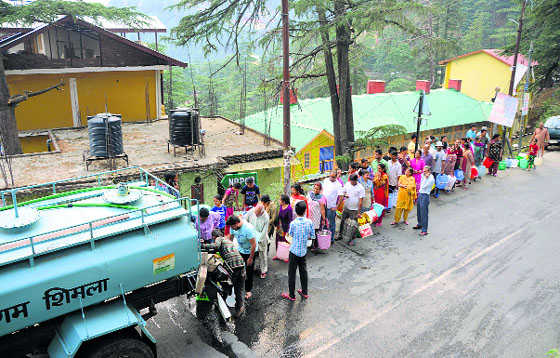
FOR A BUCKETFUL: Shimla faces acute shortage of drinking water. PTI
Tikendra Panwar
Ex-Deputy Mayor of Shimla
The accentuating water crisis in Shimla, with water being distributed only once in eight days in most localities, points to the failure of Shimla Municipal Corporation and the state government to comprehend the situation and effectively manage the crisis. People are forced to fetch water from the adjoining natural sources (bauris) which are highly contaminated.
Reasons of water crisis
1 Shimla city has supply from five major water sources — Gumma, Giri, Ashwini Khad, Churat and Seog. The overall installed capacity is 65 million litres per da (MLD) while the demand is approximately 45 MLD. Despite the higher installed capacity, the city never gets more than 35 MLD as average throughout the year. Most of the water leaks out during pumping and distribution.
2 The other major problem is that Ashwini Khad, a major source, was contaminated in 2005 when a sewage treatment plant (STP) was constructed in Malyana, just 5 km upstream. Since then, there have been periodic breakouts of hepatitis. This source met the requirements of a quarter of the city's population and its near-closure cannot be compensated even by an increase from Giri. At present, not more than 2-3 MLD of water is being pumped into the city from Ashwini Khad. The MC has to risk the outbreak of hepatitis if it insists on lifting water from this source. If it does not, the crisis would further deepen. There has to be a proper mechanism to deal with this source.
3 The third reason for the deepening of this crisis is that there are over 50 sources in and around the city which are run and operated by the Irrigation and Public Health Departments (IPH) of the state government. The IPH has virtually stopped lifting water from these sources on the pretext that they are contaminated. This has further increased the burden on the MC to ensure that water is supplied even to areas not under its jurisdiction.
Impact of climate change, building plans
Climate change and its impact seem to be profound on the Shimla city water supply system. The winters were, by and large, dry; the average rainfall was 80 per cent deficient. It rained in March and April. But the retention of water in these months is very less. The sources of water have gone 50 per cent below the average. The city is experiencing less snow and more rain, but of less duration. It means that there is less retention of water through the natural water eco-system and more flooding as rain comes in torrents. Such water cannot be harvested.
The overall building plan in the city is also a matter of concern. More embankments are required to restrict the flow of the water so that it percolates and recharges numerous water bodies. But the kind of infrastructure in place for drains, houses etc is such that water gushes fast and is hardly retained. Resilient strategies of building need to be operationalised. It is apparent that the city will have to bank on surface water for its needs. So, it must be ensured that large catchment areas around water bodies are developed so that natural water recharge takes place. Just like the Seog catchment area which is a wild life sanctuary and where no construction is allowed.
The alternatives
There has to be both immediate and long-term planning. For immediate, there must be proper monitoring and management. Proper distribution of water and checking of leakages must be done at a war footing. Government offices and colonies, both central and state, occupy almost 50 per cent of the land mass (minus forests) in Shimla city. It has to be made mandatory at least for the government offices to ensure that they become resilient and have 100 per cent rainwater harvesting in their offices and residential colonies. This planning is hardly in place.
The Greater Shimla water supply and sewage circle (GSWSSC) must be strengthened for its autonomous functioning. The duality of water supply and distribution has ended. The strengthening of the GSWSSC will make it more accountable.
But this is not sufficient. There is need to find another major source of water supply which is perennial. The growth of the city is massive. From a population of 30,000, now the city has over 2,00,000 people with over 1 lakh entering and leaving the city every day. The city also has more than 40 lakh tourists visiting every year. Hence, the present set of water sources cannot suffice. The previous MC was instrumental in forming an MoU with the World Bank for lifting water from Kol Dam. The Kol Dam water supply scheme capacity is supposed to be more than 100 MLD. This is nearly three times more than what the city gets at present. By now, the execution of the work should have begun. However, it is still at the negotiation stage. The government must ensure that the Kol Dam scheme is executed. Just like the Ghandal water scheme which was earlier executed in the Shimla rural constituency.
There cannot be excuses for lack of performance. What is required is a cohesive strategy with a plan that is well executed and monitored. Else, the city will soon see loss of people, jobs, and economy.



























